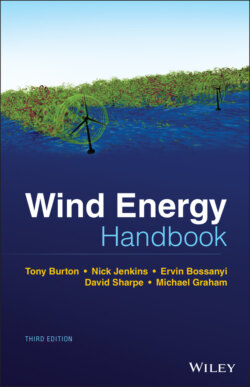Читать книгу Wind Energy Handbook - Michael Barton Graham - Страница 72
3.5.2 Blade element theory
ОглавлениеIt is assumed that the forces on a blade element can be calculated by means of two‐dimensional (2‐D) aerofoil characteristics using an angle of attack determined from the incident resultant velocity in the cross‐sectional plane of the element. Applying the independence principle (see Appendix A3.1), the velocity component in the spanwise direction is ignored. Three‐dimensional (3‐D) effects are also ignored.
The velocity components at a radial position on the blade expressed in terms of the wind speed, the flow factors, and the rotational speed of the rotor together with the blade pitch angle will determine the angle of attack. Having information about how the aerofoil characteristic coefficients Cl and Cd vary with the angle of attack, the forces on the blades for given values of a and a′ can be determined.
Consider a turbine with B blades of tip radius R each with chord c and set pitch angle β measured between the aerofoil chord‐line and the plane of the disc. (Note that in referencing the pitch to the blade chord line the zero incidence lift coefficient must be included). Both the chord length, section profile (thickness and camber), and the pitch angle may vary along the blade span. Let the blades be rotating at angular velocity Ω and let the wind speed be U∞. The tangential velocity experienced by the blade element shown in Figure 3.13 is (1 + a′)rΩ. The actuator disc is infinitesimally thin; the change in tangential velocity is abrupt, but it is only the component induced by the root vortex that contributes. This varies smoothly across the region of the actuator disc (Figure 3.10). The bound velocity induced by the vorticity on the disc does not contribute.
Figure 3.14 shows all the velocities and forces relative to the blade chord line at radius r.
From Figure 3.14, the resultant relative velocity at the blade is
(3.43)
Figure 3.13 A blade element sweeps out an annular ring.
Figure 3.14 Blade element velocities and forces: (a) velocities, and (b) forces.
that acts at an angle ϕ to the plane of rotation such that
(3.44)
The angle of attack α is then given by
(3.45)
The basic assumption of the blade element theory is that the aerodynamic lift and drag forces acting upon an element are the same as those acting on an isolated, identical element at the same angle of attack in 2‐D flow.
The lift force on a spanwise length δr of each blade, normal to the direction of W, is therefore
and the drag force parallel to W is
The axial thrust on an annular ring of the actuator disc is
(3.46)
The torque on an annular ring is
(3.47)
where B is the number of blades.
